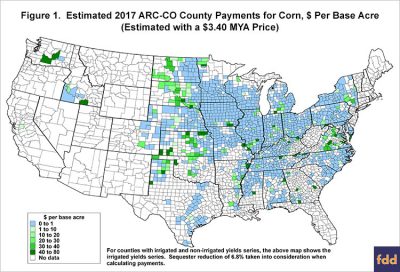Farm Progress' Joshua Baethge reported at the end of last week that "it’s hard to find anyone optimistic about passing a new farm bill this year. While the two political…
Senate Ag Committee Releases Farm Bill Draft
DTN Ag Policy Editor Chris Clayton reported on Friday that, “The farm bill that will be taken up by the Senate Agriculture Committee next week will look a lot like the current farm bill with some tweaks to commodity and conservation programs, but no radical changes from current law.
“But unlike the current battles that plague the farm bill in the House of Representatives, senior Senate committee aides who briefed reporters in a phone call Friday reiterated over, over, over and over again that the Senate farm bill is bipartisan, bipartisan, bipartisan and bipartisan.
The bill tightens income caps for farmers at the highest income levels, but the Senate farm bill does not make any major changes to the Supplemental Nutrition Assistance Program (SNAP) that prompted every House Democrat to vote against the House version of the bill last month.
Big news in the Senate! I'm on the Ag Committee and we've reached a bipartisan agreement on a new Farm Bill that will help strengthen Minnesota’s rural economy. This is what we can accomplish when we put politics aside and come together to create real solutions. pic.twitter.com/YuSVrKIlnL
— Amy Klobuchar (@amyklobuchar) June 8, 2018
The DTN article noted, “The Senate Agriculture Committee is scheduled to mark up and vote its bill out of committee on Wednesday, June 13. The 1,006-page bill was posted on the Senate website Friday.”
With respect to the commodity title, Mr. Clayton explained, “The Senate bill keeps the Agricultural Risk Coverage for both the county and individual programs, compared to the House bill, which drops the individual plan that has limited enrollment. To improve ARC, the Senate increases the transitional yield and adjusts the trend yield in the formula calculation. Like the House legislation, the Senate bill also changes yield data used for ARC from reports by the National Agricultural Statistics Service (NASS) to crop insurance data. ARC payments would be calculated on the physical location of the tract of land as well. The Senate bill would also boost the speed at which ARC data is reported to better inform farmers about potential payments.

“The Senate bill makes no changes to reference prices under the Price Loss Coverage Program.”
.@SenateAgGOP released #FarmBill18 text today & as a committee member, I’ve worked to include #NorthDakota priorities to help our #farmers & #ranchers succeed. More on what’s included in the farm bill draft here: https://t.co/cAWcDlfj6c pic.twitter.com/FUvLeLDIA0
— Senator John Hoeven (@SenJohnHoeven) June 8, 2018
In addition, the DTN article pointed out that, “But the Senate bill does tighten up the level of adjusted gross income (AGI) a person can have and still receive farm payments. The AGI would lower from the current $900,000 to $700,000. The tighter AGI cap would apply to both commodity and conservation programs.”
While discussing the conservation portion of the Senate draft, Mr. Clayton stated that, “In conservation, Senate staffers said there is no new money, but there are also no cuts. The Senate bill maintains the Conservation Stewardship Program enrollment that is eliminated in the House bill. For set-aside acreage in the Conservation Reserve Program, the Senate bumps up the acreage from 24 million acres to 25 million, compared to plans to go to 29 million acres in the House bill. The Senate plan would cut CRP rental rates to 88.5% of the average NASS rental rate in the county. That compares to the House bill that would lower the average CRP rate to 80% of the county rental-rate average.”
The draft @SenateAgGOP #FarmBill has been released, and I’m glad to see they’ve incorporated several of my #ThuneFarmBill proposals. I’m looking forward to working with my colleagues to further strengthen it and get a pro-farmer, pro-ag farm bill to @POTUS as soon as possible. pic.twitter.com/rLCIKJsmIZ
— Senator John Thune (@SenJohnThune) June 8, 2018
Meanwhile, Bloomberg writer Alan Bjerga reported late last week that, “A Senate committee released a farm bill Friday that doesn’t impose new work requirements on food stamp recipients as sought by President Donald Trump and many House Republicans, setting up a potential fight between the two chambers.
“The legislation adds complications to negotiations underway in the House, where a version of the bill failed last month because of an unrelated fight over immigration. Lawmakers in that chamber are seeking to revive the bill with the work requirements included.
Democrats almost universally reject new food stamp work requirements. Unlike in the House, where Republicans can pass legislation without the help of Democrats, a more bipartisan approach is needed in the Senate because the GOP has a narrow majority and often needs Democrats’ votes to pass legislation.
The Associated Press noted Friday that, “The House is planning to take up its version of the bill again sometime this month.”
And Reuters news reported last week that, “The Republican leader of the U.S. Senate said on Tuesday the chamber would likely take up a massive farm bill around the July 4 holiday.”
The @SenateAg Committee released it’s draft #FarmBill18 w/ several Hoosier priorities included. Joe helped craft the bipartisan bill & secured provisions based, in part, on input from his 12 listening sessions w/ nearly every segment of Indiana’s ag community: pic.twitter.com/OuDhbinXfb
— Senator Joe Donnelly (@SenDonnelly) June 9, 2018
The article indicated that, “‘In the short term, we’re going to turn to a defense authorization bill and the farm bill before, the one week around July 4th,’ Senator Mitch McConnell told reporters as he discussed the Senate’s agenda.”





